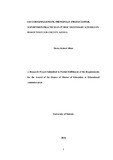| dc.description.abstract | The main aim of education in any single nation is to provide students with insights, skillfulness, dispositions and attitudes which permit them to be remodeled fruitful in the society. Consequently, education is perceived as an imperative stimulant that greatly instigates the progress and fiscal opulence of a nation and the status of liveliness of its citizenry. UNESCO (1994), recognizes education as a basic human right. Thus, most countries are focussed on providing quality and affordable education for all by the year 2015.
UNESCO (2000), emphasized strengthening of inspections of schools for effective teaching and learning. Similarly, the World Bank (2010) contended that systems of supervisions and support to schools are frequent areas of reform employed by world nations to improve their education outcomes and mitigate education challenges associated with global education policies. The supervisor’s basic aim is sensitizing, mobilizing and motivating staff in the school towards performing their duties optimally in terms of the achievement of the stated aims and objectives of the educational system. Supervision across the world is conducted depending on each country’s policy.
According to Wanjiru (2015), the capacity of education to effectively impact positively on the consumers can only be actualized by the quality and
2
standards upon which the beneficiaries access it. Many jurisdictions in the world have recognized the essence of having good follow up programs in terms of ensuring prompt delivery of good education programs. This has been by way of regulation and building the capacity of the teachers with the aim of remodeling the settingthat surround the schooling and advancement of both learners and tutors. Pedagogical supervision has, therefore, been employed as a tool to assure quality and standards upholding in many countries. The main function of instructional supervision is to offer opportunities for schools to be effective as well as to increase the adeptimprovement of teachers as medium of expertly admonishing the tutorage and learning techniques (Kutsyuruba, 2003)
In the earlier American education system, non-professionals who included the clergy, school wardens, trustees, selectmen and citizen committees handled supervision (Okumbe, 1998) In the United States of America (USA), emphasis has been placed on the employment of peer tutoring by the school administrators and managers in the wake of dispensing and undertaking their instructional supervisory roles. This has seen to it that the standards of education in the USA are upheld and the capacity of the teachers to be effective in undertaking the teaching programmes is maintained (Webb, Metha & Jordan 2010) The instructional supervisory medium has served the education fraternity in the Unites States of America well and has assured consistency in the wake of actualization of programmes without eroding the envisaged quality. Gregory defines instructional supervision as demeanors | en_US |



